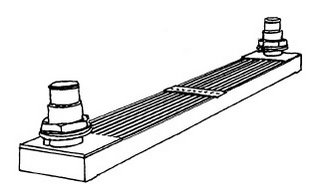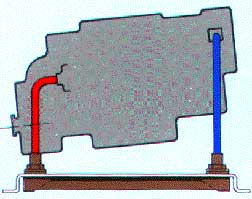Citable No. 41: TTAB Finds Drawing of Product Not Functional for Design Services
In an exhausting 56-page decision, the Board sustained an opposition to registration of the depiction shown immediately below as a service mark for the "manufacture of marine heat exchangers to the order of others," finding that the mark lacked acquired distinctiveness under Section 2(f). However, considering an issue of first impression -- whether a two-dimensional drawing may be de jure functional for services -- it rejected Opposer's claim that the alleged mark is functional. Duramax Marine, LLC v. R.W. Fernstrum & Co., 80 USPQ2d 1780 (TTAB 2006).

The Board's decision focused on four principal issues: whether Opposer Duramax had standing to oppose and whether it was estopped from opposing in light of a prior litigation settlement agreement, whether the subject mark is functional for Applicant's services, and if not, whether the mark has acquired distinctiveness (Applicant sought registration under Section 2(f)).
As to standing, Applicant Fernstrum asserted that the litigation settlement agreement restricted Opposer to the manufacture and marketing of keel coolers of a type different from that which Applicant makes. Therefore, Applicant argued, Opposer could not be damaged by the registration of this particular design. The Board disagreed.
"Even assuming that opposer is, by the settlement agreement, barred from manufacturing a keel cooler in the form represented by the depiction, the exclusive registration of assertedly descriptive matter by a competitor might provide that competitor with an advantage, for example, in marketing its products."
In addition, the settlement agreement contemplated a "possible future right of opposer to manufacture and sell keel coolers" without the restriction; if that right did not arise until more than five years after Applicant's mark were registered, Opposer would be barred (under Section 15 of the Act) from challenging the mark as descriptive. "Opposer's prospective interest in one day using the proposed mark, is a sufficient pleading of standing."
As to Applicant's estoppel argument, the Board, after an extensive analysis of the settlement agreement, concluded that Opposer was not estopped from challenging the subject application.
Turning to the functionality issue, the Board agreed with Applicant that "there is a significant difference between an application to register trade dress in the nature of product design as a mark for the product itself ... and an application to register a two-dimensional drawing that may look very much like such a product, but is used on labels, catalogs, brochures, and in various other ways as a mark for services. The inquiry regarding functionality may need to be decidedly different in the latter set of circumstances and this opposition is therefore a case of first impression for the Board." (pp. 40-41).
The Board recognized some compelling arguments against registration of a design that appeared in a now-expired patent:
"... the case at hand presents, more than the cases involving restaurant or retail kiosk trade dress, a much closer question regarding whether any manufacturer of the formerly patented item should be free to utilize, in advertising its goods for sale, a realistic depiction of the item." (p. 43)
However, Opposer failed to persuade the Board that an extension of existing law to cover the circumstance of this case was warranted. The Board explained:
"... we must balance against opposer's argument for the extension of existing case law on functionality what is shown by the record to be long use of the keel cooler depiction by applicant in a manner of a logo. Further, opposer has not discussed whether, when custom manufacturing services are involved, we should still apply the TrafFix test for functionality (a three-dimensional product design is functional if it is 'essential to the use or purpose of the product or if it affects the cost or quality of the product') to the product that results from purchasing the services, or whether the test should be adapted and focus on whether use of the two-dimensional design to be registered is essential to anyone who would provide the same service, or would, if unavailable, affect the cost or quality of the service." (p. 43)
The Board declined to sustain the functionality claim, but it added that "our decision does not foreclose the extension of TrafFix to service marks if circumstances in a future case warrant such an extension."

Finally, regarding acquired distinctiveness, the Board noted that Applicant has the "ultimate burden of persuasion" and that, although the standard is a preponderance of evidence, the standard becomes more difficult to meet as the mark's descriptiveness increases. The Board observed that there was little evidence of "look for" advertising or actual promotion of applicant's logo, nor was the logo displayed consistently in promotional materials. The extent of distribution of the promotional items was uncertain, and the promotional expenditures were not" particularly substantial." In short, weighing all the record evidence and noting that the depiction proposed for registration is "highly descriptive," the Board did not find sufficient evidence to support the claim of acquired distinctiveness.
TTABlog comments: I did not find the Board's discussion of the "issue of first impression" very enlightening. The fact that Opposer did not discuss what test should be applied does not, it seems to me, excuse the Board's failure to do so.
The Board's finding that Duramax had standing to oppose and was not estopped from opposing, despite the terms of the settlement agreement, deserves some serious attention -- particularly the next time that one negotiates a settlement agreement.
Text Copyright John L. Welch 2006.




0 Comments:
Post a Comment
<< Home